
A Practical Guide to Composting the Body After Death
The Growing Movement to Compost Body After Death
When you compost body after death, you transform human remains into nutrient-rich soil through a controlled decomposition process. Here's what this eco-friendly alternative involves:
- Process: Bodies are placed in steel vessels with organic materials like wood chips and straw
- Timeline: Takes 4-8 weeks to complete, plus 2-4 weeks for soil curing
- Output: Produces about 1 cubic yard of soil (500-1,000 pounds) per body
- Cost: Ranges from $4,000-$7,000, comparable to traditional burial
- Legal Status: Currently legal in 12 U.S. states with more pending legislation
- Environmental Impact: Uses 87% less energy than burial or cremation, saves 1 metric ton of CO₂
This isn't science fiction - it's happening right now. When Laura Muckenhoupt drove home with hundreds of pounds of soil that had once been her 22-year-old son Miles, she felt hope for the first time since his death. That soil became a rosebush in her garden and a living memorial that continues to grow.
Human composting represents a fundamental shift in how we think about death care. Instead of viewing bodies as waste to be buried or burned, this process treats them as valuable organic matter that can nourish new life. The method mimics what happens naturally on forest floors, where fallen trees and leaves decompose into rich humus that feeds the next generation of plants.
The funeral industry is taking notice. With cremation rates projected to reach 80% by 2035 and growing concerns about environmental impact, families are seeking alternatives that align with their values. Human composting offers a solution that's both environmentally responsible and emotionally meaningful.
I'm Mortuary Cooler, a national-level mortuary cooler supplier with extensive experience helping funeral homes adapt to evolving death care practices, including facilities that compost body after death. My background in mortuary equipment has given me unique insights into how this emerging practice is reshaping the industry.
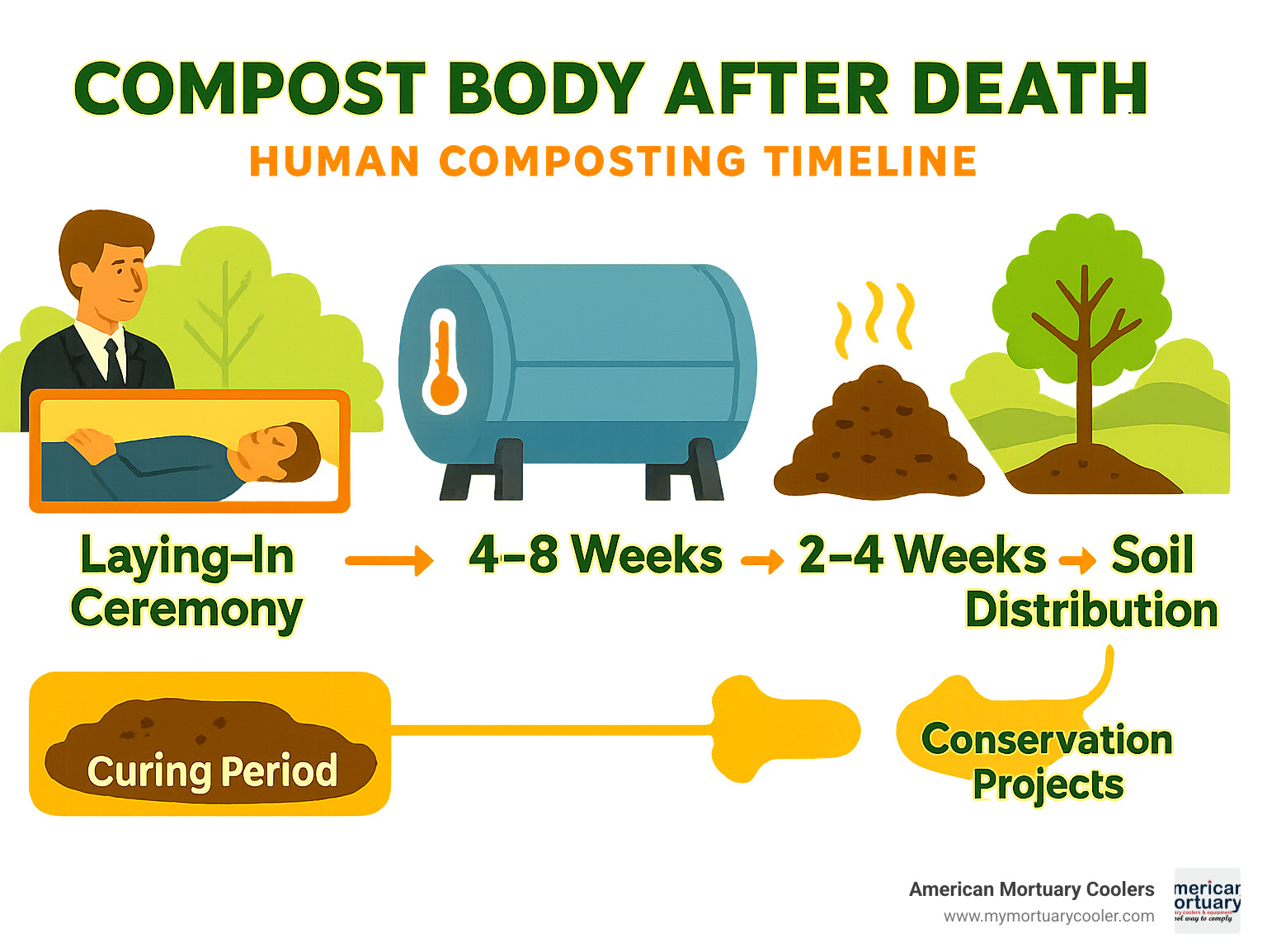
Compost body after death terms explained:
What Is Human Composting?
Human composting transforms death into new life through a surprisingly neat process. Also called natural organic reduction (NOR) or terramation, this method takes what happens naturally on forest floors and speeds it up in a controlled, respectful environment.
Picture walking through an old-growth forest. Fallen trees slowly break down over years, becoming rich soil that feeds towering cedars and delicate ferns. When you compost body after death, you're essentially creating that same change - just faster and with careful scientific oversight.
The magic happens inside specially designed stainless-steel vessels where naturally occurring microbes do all the work. These aren't exotic laboratory-grown bacteria - they're the same tiny organisms that have been decomposing organic matter for millions of years.
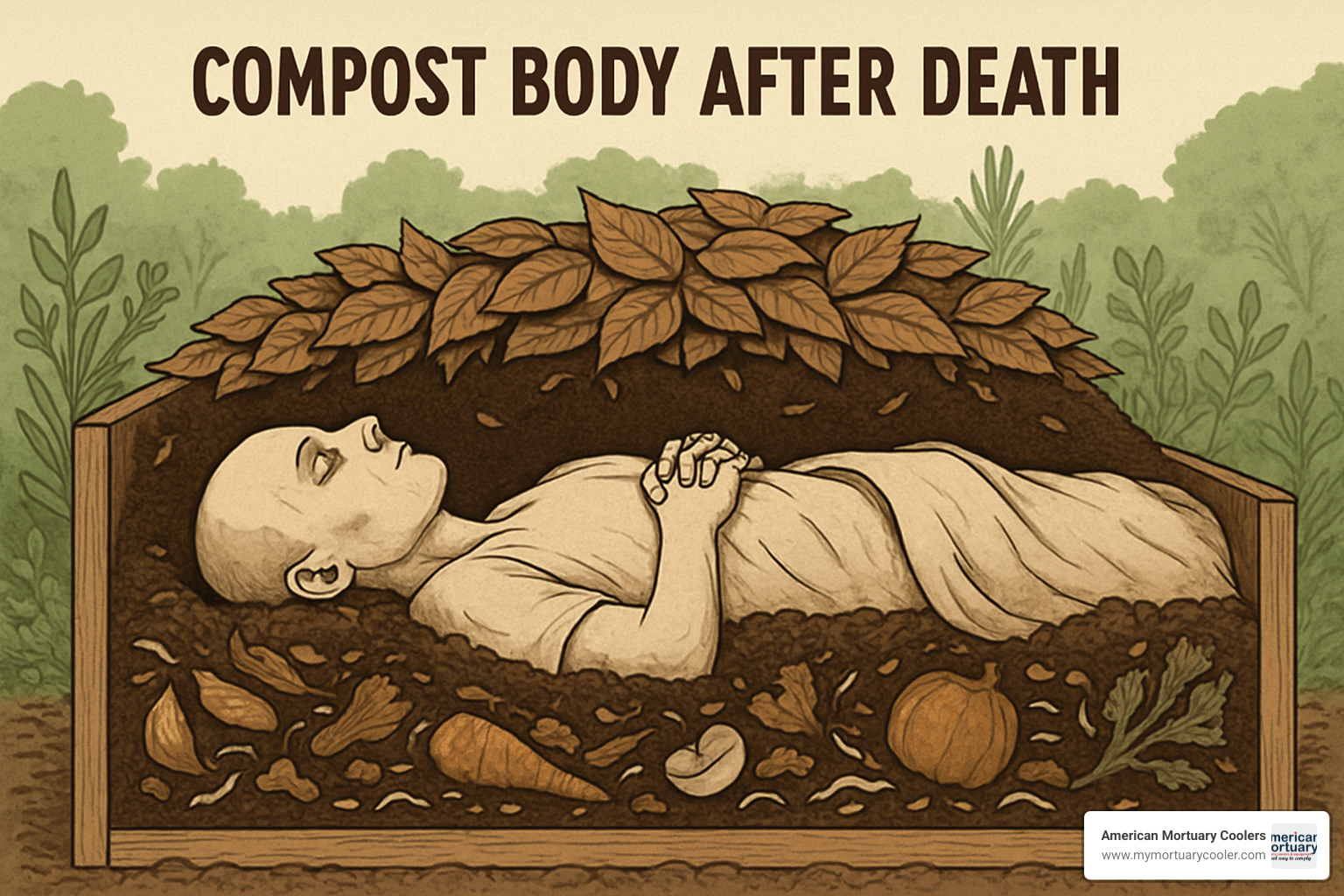
The science isn't new - farmers have been composting livestock for decades. Cornell University's extensive research on this "natural rendering" provided the foundation for scaling up to human remains.
Inside the composting vessel, everything depends on getting the carbon-nitrogen balance just right. Wood chips provide carbon, while alfalfa adds nitrogen, creating that sweet spot of 25-30 parts carbon to 1 part nitrogen that microbes absolutely love. Add some straw for structure and proper aeration, and you've got the perfect recipe for change.
Temperature control is crucial - the vessels maintain a steady 131-160°F throughout the process. That's hot enough to eliminate any harmful pathogens but cool enough to keep the beneficial microbes thriving.
From Corpse to Cubic Yard: End Result
When you compost body after death, you're looking at roughly one cubic yard of gorgeous, nutrient-rich soil weighing between 500-1,000 pounds. That's enough to fill a standard pickup truck bed with some of the richest earth you'll ever see.
This isn't ordinary dirt from your backyard. The resulting soil has a perfect pH between 6.5-7.0, balanced nutrients, and the kind of rich, dark color that makes gardeners weep with joy. It's essentially premium-grade humus - the same quality soil you'd find on a thriving forest floor.
Families describe the soil as "earthy, beautiful, vibrant, and life-giving." Many take portions home to create living memorials in their gardens, where their loved one's favorite roses or vegetables can flourish. Others choose to donate the soil to conservation projects, forest restoration efforts, or community gardens.
Why Choose to Compost Body After Death?
The choice to compost body after death usually comes from the heart - a deep feeling that there has to be a better way than what we've been doing for generations. When Maria's environmentally-conscious father passed away, she couldn't bear the thought of pumping his body full of chemicals and sealing it in a concrete vault. "He spent his whole life caring for the earth," she told me. "This felt like the only way to honor that."
Climate change is making these conversations more urgent. Traditional burial practices consume staggering resources - we're talking about 4 million acres of forest cut down annually just for caskets in the U.S. Then there's the concrete for vaults, the toxic embalming chemicals, and the endless lawn maintenance that keeps cemeteries looking pristine.
Cremation isn't much better environmentally. Each body releases about 418 pounds of CO₂ into the atmosphere - equivalent to driving from Nashville to Atlanta. That adds up to over 360,000 tons of CO₂ annually from U.S. cremations alone.
When you compost body after death, you're choosing renewal over disposal. Instead of taking from the earth or polluting it, you're giving back something valuable.
Environmental Benefits When You Compost Body After Death
The numbers behind human composting are genuinely impressive. The process uses 87% less energy than burial or cremation and saves approximately 1 metric ton of CO₂ per person, according to scientific research on carbon savings.
Here's what makes the environmental impact so significant: Human composting actually stores carbon instead of releasing it. While cremation sends carbon into the atmosphere and burial can produce methane underground, composting locks carbon into the soil where it belongs.
The water benefits are remarkable too. Soil with higher organic matter retains dramatically more water - we're talking about an additional 20,000 gallons per acre when you increase organic matter by just 1%. In drought-prone areas, this kind of water retention can make the difference between thriving ecosystems and barren landscapes.
No toxic chemicals enter the environment when you compost a body. Compare that to traditional embalming, which uses over 800,000 gallons of formaldehyde and other chemicals annually in the U.S.
Costs and Savings When You Compost Body After Death
Human composting typically costs between $4,000-$7,000 for complete services. This puts it right in the middle - more than basic cremation but less than traditional burial with all the extras.
The pricing makes sense when you consider what's included. You're getting a meaningful service plus about a cubic yard of premium soil - that's hundreds of pounds of nutrient-rich material that would cost hundreds of dollars to purchase commercially.
Traditional burial often has hidden costs that add up quickly. Cemetery plots, concrete vaults, perpetual care fees - these can push total costs well above $10,000. With human composting, what you pay upfront is what you pay total.
For detailed breakdowns of all costs involved, our team has put together a comprehensive guide on human body composting that covers the financial aspects thoroughly.
Legal Map & Growing Access
Human composting is currently legal in 12 states: Washington, Colorado, Oregon, Vermont, California, New York, Nevada, Arizona, Maryland, Delaware, Minnesota, and Maine. The momentum is building fast, with bills pending in 8 additional states.
Washington broke ground as the first state in 2019, and the domino effect has been steady ever since. California's law doesn't take effect until 2027, but other states are moving more quickly through their legislative processes.
Even if your state hasn't legalized it yet, you have options. Families regularly transport their loved ones to facilities in legal states. It requires some coordination with local funeral homes and proper permits, but it's completely doable and happens regularly.
The current status of legislation on human composting by state gets updated regularly as new bills move through state legislatures.
How the Human Composting Process Works
The journey to compost body after death unfolds like a carefully choreographed dance between science and ceremony. Each step honors both the person who has died and the natural processes that will transform them into new life.
The story begins with a laying-in ceremony - a gentle alternative to traditional viewings. Instead of embalming chemicals and metal caskets, the body is wrapped in a simple biodegradable shroud made from natural fibers. There's something deeply peaceful about this simplicity.
Families often find this moment surprisingly healing. Some decorate the vessel with photos and flowers, others share stories or read favorite poems. Return Home, one of the leading providers, welcomes families to visit throughout the entire process.
Then comes the science part. The body is placed inside a stainless-steel vessel - picture something about the size of a small truck bed, roughly 8 feet long by 4 feet tall. The body rests on a soft bed of wood chips, alfalfa, and straw that smells like a barn in the best possible way.
This mixture isn't random. The materials create a precise carbon-to-nitrogen ratio of 25-30:1 - the sweet spot that makes microbes absolutely thrive. Wood chips provide carbon, while alfalfa adds nitrogen. It's the same balance that makes compost piles work in backyard gardens, just scaled up.
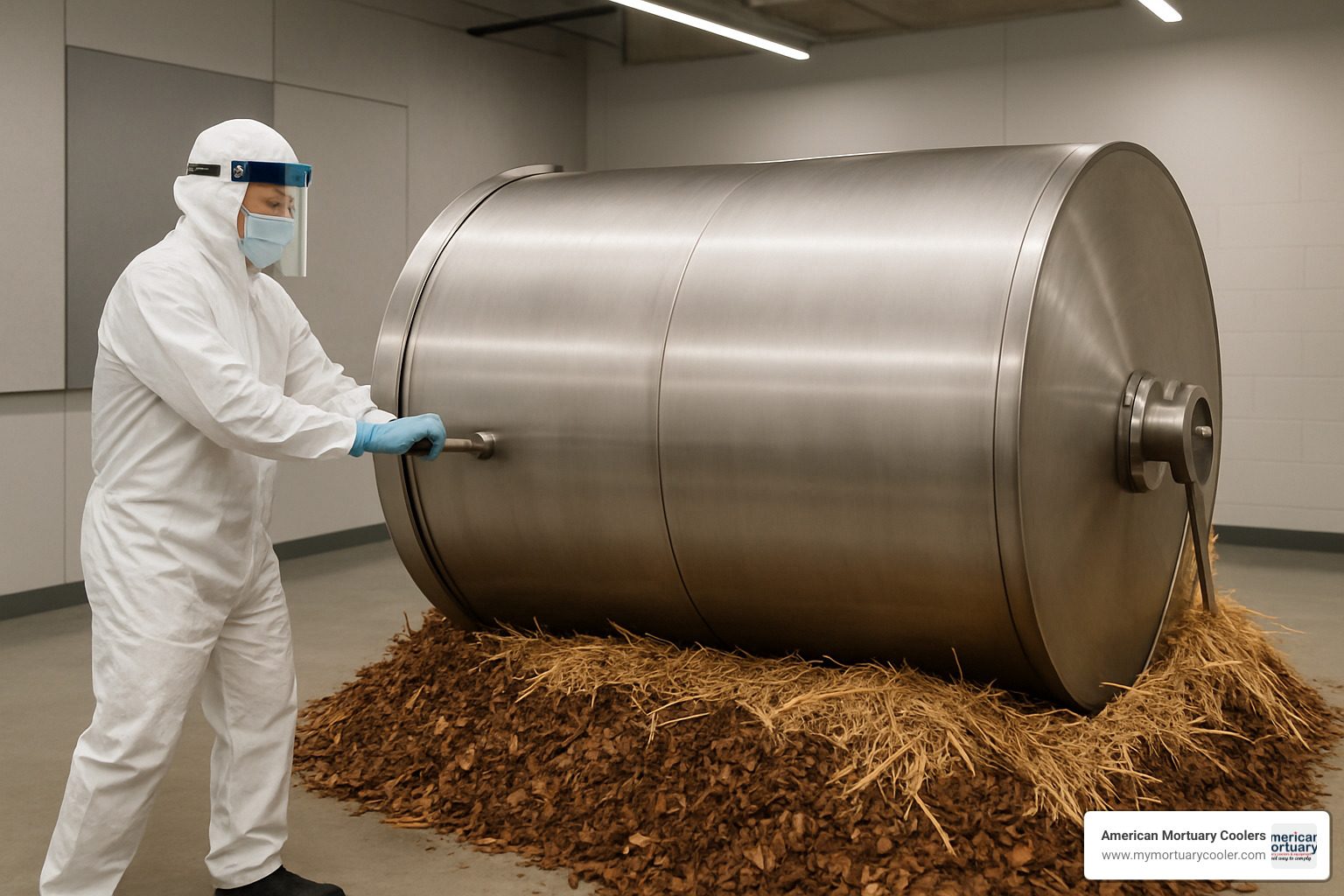
Over the next 4-8 weeks, nature takes over. Billions of naturally occurring microbes - the same ones that decompose fallen leaves on forest floors - begin their work. The vessel warms up to 131-160°F from microbial activity alone. No external heat needed. No electricity. Just life changing life.
Staff rotate the vessel every few days to keep oxygen flowing. This isn't just busywork - those beneficial microbes need air to stay active and healthy. Without proper aeration, the whole process could turn anaerobic and smelly. With it, decomposition proceeds cleanly and safely.
The heat serves a crucial purpose beyond decomposition. Maintaining 131°F for at least three continuous days kills any pathogens, ensuring the final soil meets the same safety standards as commercial compost operations. Temperature monitoring happens around the clock.
After 4-8 weeks, the active phase is complete. But the process isn't over yet. The compost moves to a curing phase lasting another 2-4 weeks, where the soil stabilizes and any remaining organic matter finishes breaking down.
What Happens to Bones, Teeth & Implants
The question everyone asks: what about the bones? The composting process softens bones significantly, but they don't completely disappear. After the initial decomposition, any remaining bone fragments are carefully removed and processed into fine powder using specialized equipment.
This bone powder gets mixed back into the soil, adding valuable minerals like calcium and phosphorus. It's essentially the same as bone meal fertilizer that gardeners buy at nurseries, just produced through a more meaningful process.
Metal implants follow a different path entirely. Hip replacements, dental work, pacemakers - everything gets carefully screened out during the finishing process. Most metals can be recycled, so nothing goes to waste.
Materials & Microbiology Essentials
Success in human composting comes down to creating a five-star hotel for microbes. These beneficial bacteria and fungi are incredibly particular about their environment, and keeping them happy is what makes the whole process work.
The carbon-to-nitrogen ratio of 25-30:1 is absolutely critical. Too much nitrogen from the body and the pile becomes smelly and anaerobic - definitely not what anyone wants. Too much carbon from wood chips and decomposition slows to a crawl. The precise blend of wood chips, alfalfa, and straw hits this balance perfectly.
Moisture control matters just as much. The pile needs to stay between 40-60% moisture content - damp like a wrung-out sponge but not soaking wet. Too dry and the microbes can't work. Too wet and oxygen can't flow, killing the beneficial bacteria.
Soil Handling & Memorial Options
When the process is complete, families face a beautiful decision: what to do with a pickup truck's worth of rich, dark soil. Many take it home for memorial gardens, using it to plant trees, flowers, or vegetables that held special meaning for their loved one.
Others choose to donate some or all of the soil to conservation projects. Recompose partners with organizations doing forest restoration, wetland rehabilitation, and habitat creation. The donated soil helps heal damaged ecosystems while creating a lasting environmental legacy.
Some families get wonderfully creative with distribution. We've heard stories of soil being sent to Indonesia, Tuscany, Portugal, and Hawaii for plantings in places that held deep significance. Under Washington law, composted remains can be spread anywhere with landowner permission - the same rules that apply to cremated ashes.
For more detailed information about soil handling and memorial options, visit our guide on how to compost a body with guaranteed results.
Regulations, Providers & The Future of Human Composting
The human composting industry is growing up fast. What started as a handful of pioneering facilities is now becoming a regulated, professional sector with established standards and expanding options for families who want to compost body after death.
The regulatory landscape is taking shape across the 12 states where human composting is legal. Washington led the way with comprehensive rules covering everything from facility design to soil testing protocols. Other states are following suit, creating frameworks that ensure safety while allowing innovation.
These regulations aren't just bureaucratic paperwork - they're building trust. Facilities must maintain detailed temperature logs proving that harmful pathogens are eliminated. They test the final soil for everything from E. coli to pH levels. The ASTM (American Society for Testing and Materials) is developing national standards that will bring even more consistency to the industry.
Several companies are leading this change. Recompose in Seattle broke ground as the first commercial facility, operating 10 vessels and proving the concept works at scale. Return Home in Auburn, Washington went bigger, installing 74 custom-designed vessels on an 8-acre property that feels more like a peaceful retreat than an industrial facility.
Earth Funeral is taking a different approach, focusing on scalable facility designs that can be replicated across multiple states. Meanwhile, Herland Forest combines human composting with natural burial options, giving families even more choices for eco-friendly death care.
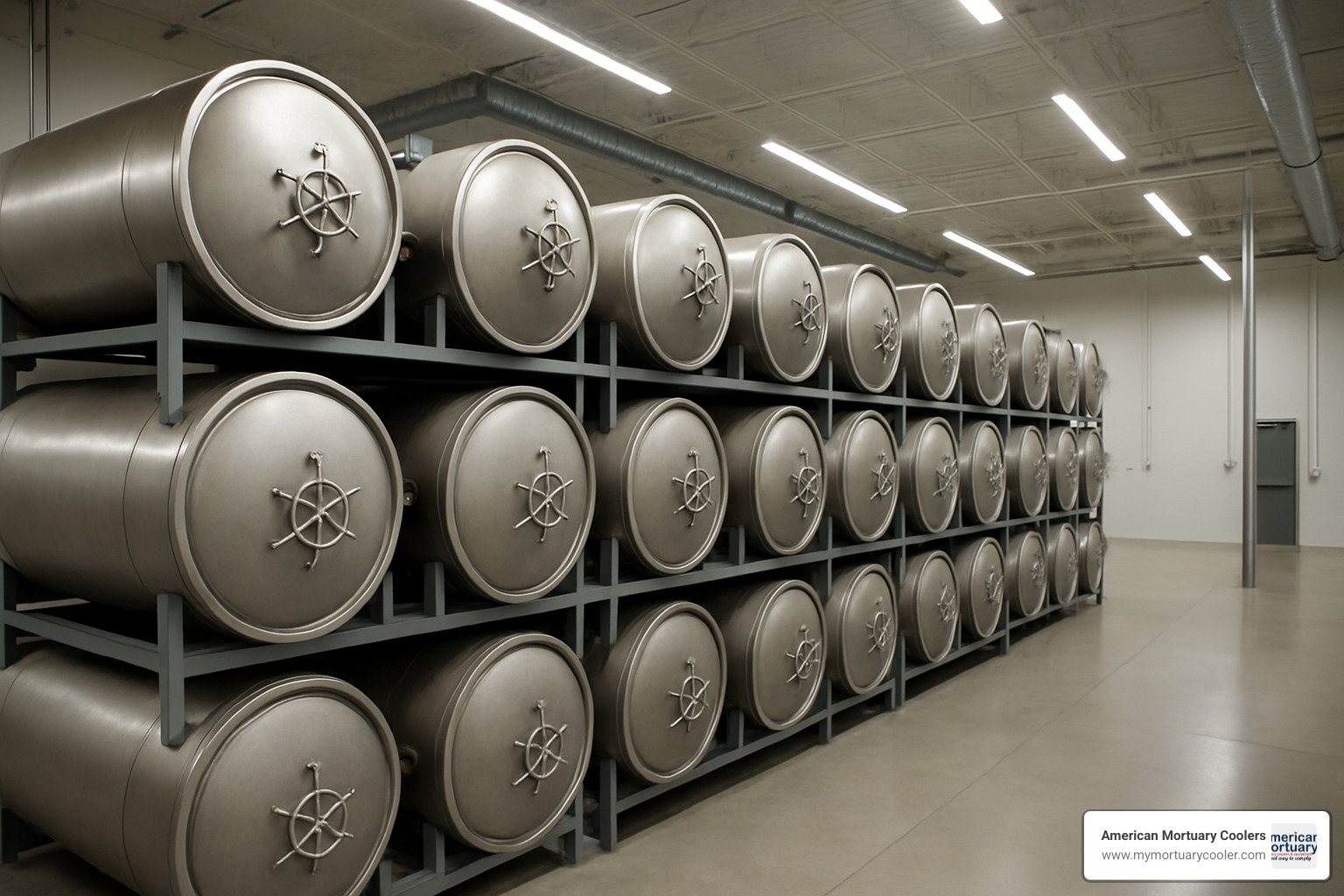
Behind the scenes, the equipment needs are sophisticated. These facilities require precise temperature monitoring systems to track each vessel continuously. Aeration equipment maintains proper oxygen levels for healthy decomposition. Specialized screening systems remove any inorganic materials from the finished soil.
At American Mortuary Coolers, we've been working with facilities planning composting services. Our experience with precise environmental controls in mortuary coolers translates well to the temperature and humidity requirements these operations demand.
The growth trajectory is impressive. With 60% of Americans already choosing cremation over burial, and environmental consciousness rising, human composting is positioned to capture significant market share in states where it's legal. We're seeing funeral homes inquire about adding these services, especially in areas with environmentally conscious populations.
International interest is heating up too. Canada is evaluating legislation, and several European countries are watching the American experiment closely. The global green burial movement is creating momentum that extends far beyond U.S. borders.
The technology keeps improving as well. We're seeing automated monitoring systems that track temperature and moisture levels remotely. Vessel designs are becoming more efficient, reducing processing time while maintaining safety standards. As the industry matures, costs should decrease while quality becomes more consistent.
For funeral directors considering this service, the infrastructure investment is significant but manageable. The key is understanding the specialized equipment requirements and regulatory compliance from day one. Our comprehensive guide on human composting equipment and facility requirements covers what you need to know about entering this growing market.
This isn't just a trend - it's a fundamental shift in how Americans think about death care. As more states legalize human composting and facilities expand their capacity, we expect this option to become as common as cremation in many regions.
Frequently Asked Questions about Compost Body After Death
How long does the whole composting cycle take?
When families ask about timing, I always tell them the complete process to compost body after death takes about 8-12 weeks from start to finish. This isn't a rushed process - and that's exactly how it should be.
The journey breaks into two main phases. First comes the active decomposition phase, lasting 4-8 weeks inside the vessel. During this time, your loved one rests at temperatures between 131-160°F while beneficial microbes do their work. Staff rotate the vessel regularly to ensure proper airflow and even decomposition throughout.
Then comes the curing phase, which takes another 2-4 weeks. Think of this like letting bread rise - the soil needs time to stabilize and complete its change. Any remaining organic matter finishes breaking down during this quiet period.
The timeline can shift slightly based on your loved one's size, the season, and each facility's specific protocols. But most providers stick closely to this schedule, and they'll keep you updated throughout the process.
Is the resulting soil safe for food gardens?
This is probably the most common concern families have, and I completely understand why. The answer is a resounding yes - the soil is absolutely safe for growing food.
The science behind this safety is solid. When you compost body after death, those high temperatures of 131°F maintained for at least three continuous days eliminate all harmful pathogens. This follows the same EPA standards used for commercial composting operations across the country.
Before any soil leaves the facility, it undergoes rigorous testing. Labs check for dangerous bacteria like E. coli and Salmonella, screen for heavy metals, and verify the pH levels. The final soil typically has a pH between 6.5-7.0, which is perfect for most plants - from tomatoes to apple trees.
Many families tell us they've used the soil in their vegetable gardens, herb plots, and fruit trees without any concerns. The nutrient profile is actually similar to premium commercial compost you'd buy at a garden center, just with deeper meaning behind it.
Can families witness or participate in the process?
Here's where human composting really shines compared to traditional options. Most facilities not only allow family participation - they encourage it. This transparency sets composting apart from burial or cremation, where families are often shut out of the actual process.
At facilities like Return Home, families can visit their loved one's vessel throughout the composting period. Imagine being able to check in, leave flowers, or simply sit quietly nearby. It's a level of connection that's impossible with other death care options.
The laying-in ceremony offers another meaningful way to participate. Families often decorate the vessel with photos, flowers, and objects that held special meaning. Some facilities offer guided tours so you can understand exactly what's happening and why.
When the process completes, many families choose to help with soil collection and even participate in the final screening if they want. This hands-on approach helps people find closure and meaning in their loved one's change. As one family told us, "We weren't just saying goodbye - we were helping with the next chapter of his story."
Conclusion
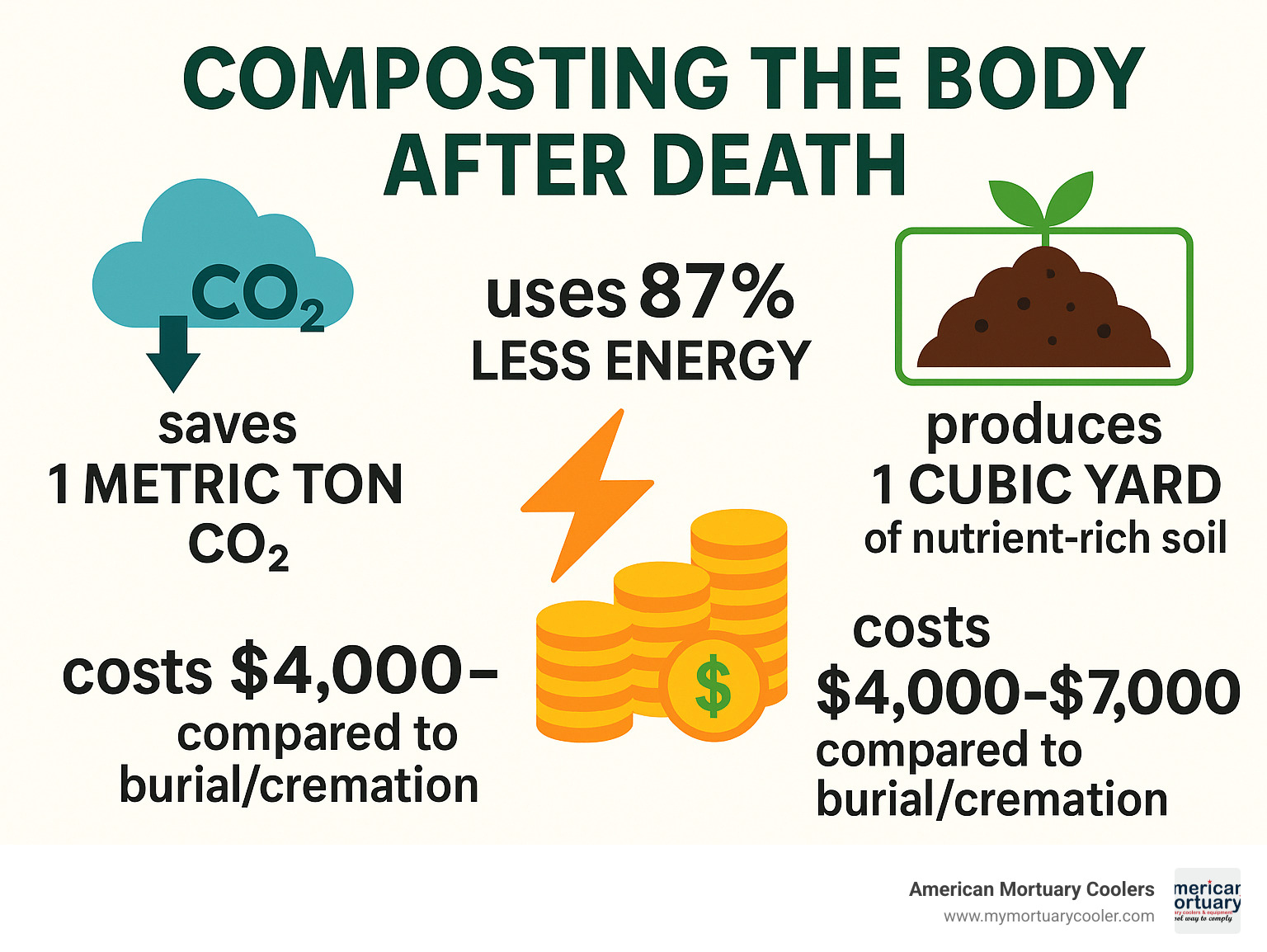
When families choose to compost body after death, they're writing a different ending to the story of life. Instead of "ashes to ashes" or "rest in peace," it becomes "from person to soil to new growth." There's something profoundly hopeful about that change.
Laura Muckenhoupt's story - driving home with her son Miles transformed into hundreds of pounds of rich soil - captures what makes human composting so different. Traditional burial feels like an ending. Cremation gives you ashes to keep or scatter. But composting? It gives you the beginning of something new.
The numbers tell part of the story - 87% less energy use, one metric ton of CO₂ saved, $4,000-$7,000 in costs that compete with traditional options. But the real story is in what families do with that cubic yard of soil. Rose gardens. Memorial forests. Vegetable plots that feed the family for years. Conservation projects that heal damaged landscapes.
As American Mortuary Coolers, we've been watching this movement grow from our base here in Tennessee. Funeral directors from California to Maine are calling us about the specialized equipment needed for composting facilities. The questions aren't just about refrigeration anymore - they're about temperature monitoring systems, vessel rotation equipment, and soil screening technology.
What excites us most is the innovation happening in this space. The same engineering principles that make our mortuary coolers reliable and durable are being applied to composting vessels. Precise temperature control. Consistent environmental conditions. Equipment that works day after day without fail.
The legal landscape keeps expanding too. Twelve states now, with more legislation pending every year. Each new state means more families getting access to this option, and more funeral homes needing the right equipment to serve them.
This isn't just about death care evolving - it's about closing the loop on life in a way that makes sense for our planet. Climate change isn't going away. Land scarcity in urban areas is getting worse. The old ways of handling human remains consume enormous resources while giving nothing back.
Human composting flips that equation. It takes something that was traditionally a burden and transforms it into a resource. It turns grief into growth, literally. For families dealing with loss, knowing their loved one will continue nurturing life provides comfort that traditional methods simply can't match.
The future looks bright for this industry. As more states legalize human composting and more facilities open, we expect to see continued improvements in technology and efficiency. The equipment will get better, the processes will become more streamlined, and costs should come down over time.
For funeral professionals ready to explore this option, we're here to help with the specialized equipment and expertise needed. Our experience with precision temperature control and durable construction translates perfectly to composting facility needs. Visit our comprehensive resource center to learn how we can support your facility's growth into this emerging market.
The movement to compost body after death represents hope - hope for the environment, hope for meaningful end-of-life choices, and hope that death can nurture new life. In a world that often feels focused on endings, human composting reminds us that every ending can also be a beginning.



